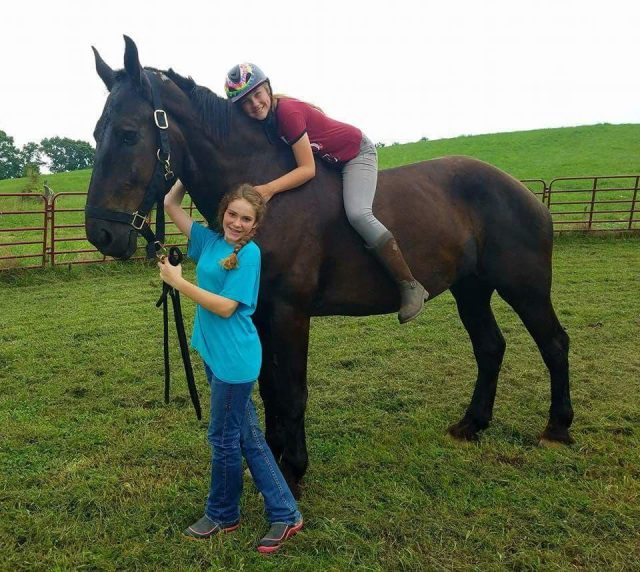
So You Want to Rescue a Horse? Part II: Finding the Right Horse
Successful rescue still requires a good match.
Catch up on the first installment: Part I: Adopting From a Rescue Organization
Whether you adopt your rescue from a nonprofit, or go bid on animals at auction, here are a few things to keep in mind to help you select the right animal for you.
Choosing a rescue horse
Decide on what age animal you want to rescue. Looking for a young horse, perhaps even a foal? Nonprofits, such as Last Chance Corral, specialize in rescuing nurse mare foals and adopting them out. Some of their adoptables are merely days old so if you are up for the feeding and care of a baby, there are many that need good homes.
Nurse mare foals run the gamut from draft crosses that look like expensive warmblood babies to gaited animals of every possible rhythm – some walk, others rack, and some foxtrot. These foals come in every color combination under the rainbow. Some will grow to be 17 hands while others will be on the “large pony” end of the spectrum. Some are exquisite, so it is wise to dispel the myth that these babies are ill-bred ugly mutts and evaluate these foals as you would any other baby horse. Keep in mind they have been removed from their mother at a very tender age and thus will need to be educated on “how to be a horse.” Like any young horse, things that may seem “cute” when they weigh 150 pounds can evolve into dangerous behavior when your baby has grown to 1,000 pounds. Some foal rescues also require that you adopt two foals at one time.
Other options for adopting young animals include weanling or yearling mustang adoption or PMU foal adoption.
Do you want an aged retiree to be your equine lawn mower? All over the country, many “pasture sound only” animals need good homes. Just tell the rescue organizations you contact that you don’t mind if the horse you adopt cannot be ridden.
Do you want to retrain a young, well-bred animal, such as an off-track Thoroughbred (OTTB) or off-track Standardbred (OTSB)? Some nonprofit organizations like New Vocations Racehorse Adoption Program can help you find a lovely animal who has finished its racing career yet may be very young with a full riding career ahead of it.
Often such organizations are very adept at matching horses and riders. So if you want a new eventing prospect, dressage prospect, or trail prospect that has been exposed to all the rigors of the racing world and is thus well on their way to the sacred status of “sane, sound, and sensible” an off-track horse may be just the one for you.
Purchasing directly from auction
It is wise to have your list of “must have” qualities well in mind before you seek out your rescue horse, particularly if you opt to buy directly at auction.
If you want a stock horse that’s trail savvy and eight to ten years old, keeping that in mind will help you walk past the adorable green yearlings and the elegant four-year-old Arabians and all the others that are not what you have in mind for your riding partner.
Nonprofit organizations typically have some sort of “take back” policy if a match does not work out, but auction houses do not. So if your emotions take hold and you buy that cute three year old mini stud at auction, the animal is now your responsibility.
If at all possible, go and see the horse in person, and try it under saddle and/or in harness if it is advertised as, “broke to ride” or “broke to drive.” Also, take the animal’s condition as posted with a giant grain of salt. While some auction horses are exactly as advertised, others are not.
As one rather dramatic example, a local friend saw some pictures and a short video of a lovely black Percheron gelding for sale at an auction up north. She instantly fell in love with the big guy. The animal was on a short timeframe, so my friend had no time to go to New Jersey and personally inspect the horse, so she relied on the video. The video illustrated the horse was clearly broke to ride, and the handler noted, “he has an abscess behind his ear.”
Whether the handler was misinformed, did not know, or was being deceitful, the horse, dubbed, “Lazarus” by his adoring new owner, turned out to have poll evil. The University of Tennessee College of Veterinary Medicine speculate the poll evil was caused from constant pressure due to being worked in a headstall that was much too small for this massive animal.
Over the past two years, “Laz” has had several surgeries to try and carve out all the infection; some of these surgeries have included removal of some vertebra bone tissue. Still, so far, every few months, the site erupts yet again and a sticky, stinky discharge begins flowing and back to UTCVM goes Lazarus for another surgery.
Lazarus won the owner jackpot when my friend rescued him; many owners would have had neither the means nor the patience to constantly treat such a chronic condition. The point to remember here, however, is that the animal was advertised as having merely “an abscess.”
Finding your dream horse among the animals that most need good homes is a very rewarding experience. It can also be fraught with challenges. Knowing ahead of time what you seek in your next horse, being flexible with the nonessentials (like color and pedigree, for examples), and checking the horse out as carefully as possible before buying will help you find exactly what you are looking for.
Don’t miss the next installments: Part III: How Auctions Work and Part IV: Buying Your Horse







Leave a Comment